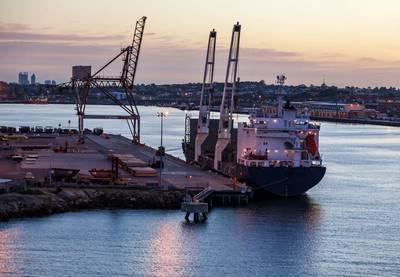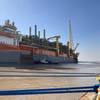Australian Government Supportive of Strategic Fleet Development Proposals
The Australian Government has released the report of the Independent Taskforce on the Strategic Fleet, along with its official response to the report, confirming a commitment to delivering a Strategic Fleet of up to 12 vessels that will help Australia build resilience to freight disruptions while supporting our maritime workforce and sovereign capability.
Australia’s maritime sector has long been neglected with a shortage of Australian flagged ships and a skilled workforce, says Federal Minister for Infrastructure, Transport, Regional Development and Local Government Catherine King.
The Taskforce found that the proposed fleet would be able to be relied on in times of national crisis and emergency, helping get vital goods to affected regions and making Australia less reliant on international shipping.
The report provides 16 recommendations, and the government has agreed to 12 of them in full or in principle, while committing to continue exploring the remaining four.
Recommendation 1: The Taskforce recommends the identified cost gap between Australian and foreign vessels be addressed through a combined measure of shipping taxation incentives in line with international norms, and Australian Government financial assistance provided to ship owners and operators.
The Australian Government agrees in-principle with this recommendation.
Recommendation 2: The Taskforce recommends that the strategic fleet comprise vessels of the following types, and be of a size that will meet the three prime strategic purposes of the fleet – to respond to disruption events, support sovereign manufacturing industries and to support the Defence Forces:
• Container vessels with geared ship cranes capable of independent container operations.
• Multipurpose vessels (MPV) capable of carrying project cargo, containers and some bulk cargoes, and unload these using geared ship cranes.
• Roll-on roll-off/roll-on lift-off (RO-RO/RO-LO) vessels.
• Liquid bulk vessels configured to carry multiple grades of fuel and chemical products in independent tanks.
• Dry-bulk vessels.
• Break-bulk vessels.
The Australian Government notes this recommendation and will seek a range of maritime capabilities from the strategic fleet to enable it to deploy the most suitable vessel type to respond to a range of circumstances.
Recommendation 3: The Taskforce recommends that the Government establish a levy on vessel arrivals as a mechanism to fund the strategic fleet.
The Australian Government notes this recommendation and will consider funding options.
Recommendation 4: The Taskforce recommends that strategic fleet vessels must be registered on the Australian General Shipping Register.
The Australian Government agrees with this recommendation.
Recommendation 5: The Taskforce considers there is merit in the Government reviewing the provisions of the Australian International Ship Register to identify if they can be made more attractive to encourage the registration of vessels under this Australian register.
The Australian Government agrees with this recommendation.
Recommendation 6: The Taskforce recommends that the Government should review the Coastal Trading (Revitalising Australian Shipping) Act 2012 to ensure the object and the provisions of the Act support the implementation of the strategic fleet.
The Australian Government agrees with this recommendation.
Recommendation 7: The Taskforce recommends that the Government provide additional funding to the Fair Work Ombudsman to increase compliance activities relating to the payment of Seagoing Industry Award 2020 Schedule A Wages on foreign vessels operating under Temporary Licence.
The Australian Government agrees in-principle with this recommendation.
Recommendation 8: The Taskforce recommends the Government legislate the power to requisition Australian-flagged vessels and establish a complementary capacity to requisition vessels through contractual arrangements with vessel owners and operators of strategic fleet and non-strategic fleet vessels to provide it with the greatest flexibility and assurance of access to vessel capability when required.
The Australian Government agrees in-principle with this recommendation.
Recommendation 9: The Taskforce recommends that the Transport and Logistics Jobs and Skills Council (JSC) expedite its Maritime Workforce Development Plan and work in collaboration with Commonwealth and state government agencies and industry to ensure that the maritime training package is fit for purpose and considers the needs of Australia’s maritime industry in the context of implementation of the strategic fleet.
The Australian Government agrees in-principle with this recommendation.
Recommendation 10: The Taskforce recommends that the Government should legislate to implement a training levy on maritime industry participants that are beneficiaries of STCW qualified seafarers to fund a financial assistance package to assist employers and sponsors of trainees and cadets to meet the costs of training seafarers to obtain STCW qualifications.
The Australian Government notes this recommendation.
Recommendation 11: The Taskforce recommends that the Government should establish a cadetship or similar scheme to provide financial assistance to organizations that provide berths for cadets and trainees to complete mandatory sea time requirements to obtain STCW qualifications.
The Australian Government agrees in-principle with this recommendation.
Recommendation 12: The Taskforce recommends the Government mandate a minimum number of training berths be offered on each vessel in the strategic fleet per annum on top of the existing minimum number of trainees as required to access the zero corporate tax regime. Any additional costs arising from the mandate should be met by one of the funding options proposed for the strategic fleet to ensure it does not create a disincentive to joining the strategic fleet.
The Australian Government agrees in-principle with this recommendation.
Recommendation 13: The Taskforce recommends the:
a. Australian Maritime Safety Authority, civilian mariner institutions, Defence and the Transport and Logistics Jobs and Skills Council work collaboratively to explore opportunities to facilitate greater alignment between Defence and civilian maritime training and qualifications to enable more flexible movement between Navy and the commercial sector
b. Australian Maritime Defence Council be re-established to become the principal forum through which the Defence/Navy sealift and other requirements such as workforce development can be harmonised with the civilian shipping industry and strategic fleet ship owners/operators to support the Government’s national security and defence objectives, including those arising from the Defence Strategic Review.
The Australian Government agrees with the first component of this recommendation.
Recommendation 14: The Taskforce recommends the Government consider targeting an increase in migration for STCW qualified seafarers to help alleviate labor shortages in Australia’s maritime industry until such time as the supply of appropriately qualified Australian seafarers increases sufficiently.
The Australian Government notes this recommendation.
Recommendation 15: The Taskforce recommends that the Government undertake further investigation of opportunities identified for measures that could complement the strategic fleet or support broader outcomes of Government.
The Australian Government agrees in-principle with this recommendation.
Recommendation 16: The Taskforce recommends that a Post Implementation Review be conducted a year after the first strategic fleet vessels are selected and receive government assistance.
The Australian Government agrees with this recommendation.
“We are getting on with the job of revitalizing Australia’s long neglected maritime sector,” says King. “The creation of a Strategic Fleet will build Australia’s resilience, and protect our national security and economic sovereignty by enabling the movement of cargo in a time of crisis.”













